
Locksmithing is the science and art of making and defeating locks. Locksmithing is a traditional trade and in many countries requires completion of an apprenticeship. The level of formal education legally required varies from country to country from none at all, to a simple training certificate awarded by an employer, to a full diploma from an engineering college, in addition to time spent working as an apprentice.

Lock picking is the practice of unlocking a lock by manipulating the components of the lock device without the original key.
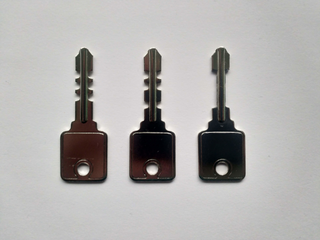
A warded lock is a type of lock that uses a set of obstructions, or wards, to prevent the lock from opening unless the correct key is inserted. The correct key has notches or slots corresponding to the obstructions in the lock, allowing it to rotate freely inside the lock.
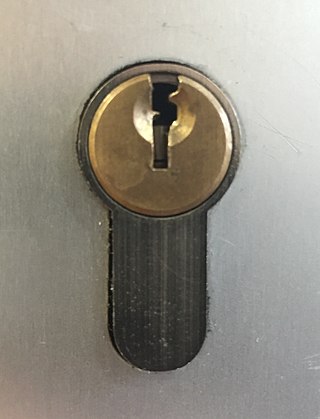
The pin tumbler lock, also known as the Yale lock after the inventor of the modern version, is a lock mechanism that uses pins of varying lengths to prevent the lock from opening without the correct key.

A disc tumbler or disc detainer lock is a lock composed of slotted rotating detainer discs. The lock was invented by Finnish founder of Abloy, Emil Henriksson (1886–1959) in 1907 and first manufactured under the Abloy brand in 1918.

A tubular pin tumbler lock, also known as a circle pin tumbler lock, radial lock, or the trademark Ace lock popularized by manufacturer Chicago Lock Company since 1933, is a variety of pin tumbler lock in which a number of pins are arranged in a circular pattern, and the corresponding key is tubular or cylindrical in shape. Most locks use between six and eight pins, although some use as few as four or as many as ten. The devices have been widely used on vending machines, elevators, public computers, and bicycle locks.

A lock is a mechanical or electronic fastening device that is released by a physical object, by supplying secret information, by a combination thereof, or it may only be able to be opened from one side, such as a door chain.

A lever tumbler lock is a type of lock that uses a set of levers to prevent the bolt from moving in the lock. In the simplest form of these, lifting the tumbler above a certain height will allow the bolt to slide past.

A Chubb detector lock is a lever tumbler lock with an integral security feature, a re-locking device, which frustrates unauthorised access attempts and indicates to the lock's owner that it has been interfered with. When someone tries to pick the lock or to open it using the wrong key, the lock is designed to jam in a locked state until either a special regulator key or the original key is inserted and turned in a different direction. This alerts the owner to the fact that the lock has been tampered with.
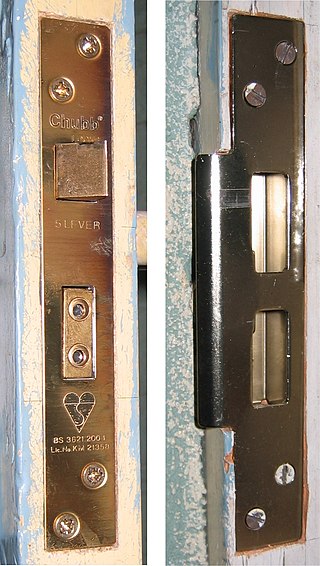
A mortise lock is a lock that requires a pocket—the mortise—to be cut into the edge of the door or piece of furniture into which the lock is to be fitted. In most parts of the world, mortise locks are found on older buildings constructed before the advent of bored cylindrical locks, but they have recently become more common in commercial and upmarket residential construction in the United States. The design is widely used in domestic properties of all vintages in Europe.

Joseph Bramah was an English inventor and locksmith. He is best known for having improved the flush toilet and inventing the hydraulic press. Along with William Armstrong, 1st Baron Armstrong, he can be considered one of the two fathers of hydraulic engineering.

Padlocks are portable locks usually with a shackle that may be passed through an opening to prevent use, theft, vandalism or harm.

Alfred Charles Hobbs was an American locksmith and inventor. He was born in Boston, Massachusetts, in 1812; his father was a carpenter. He married Charlotte F. Nye (1815-?) of Sandwich, Massachusetts, in 1835 and had four children: Charlotte Hobbs, Alfred J. Hobbs (1843-?), Mary H. Hobbs, and Arthur Hobbs. Both of his parents were born in England.
Ardeshir Burjorji Sorabji Godrej (1868–1936) was an Indian businessman. With his brother Pirojsha Burjorji, he co-founded the Godrej Brothers Company, the precursor of the modern Godrej Group.
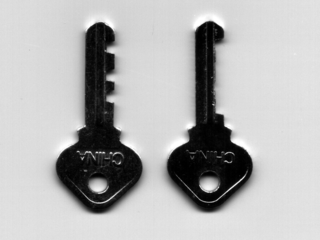
A skeleton key is a type of master key in which the serrated edge has been removed in such a way that it can open numerous locks, most commonly the warded lock. The term derives from the fact that the key has been reduced to its essential parts.
Rekeying a lock is replacing the old lock pins with new lock pins.

A wafer tumbler lock is a type of lock that uses a set of flat wafers to prevent the lock from opening unless the correct key is inserted. This type of lock is similar to the pin tumbler lock and works on a similar principle. However, unlike the pin tumbler lock, where each pin consists of two or more pieces, each wafer in the lock is a single piece. The wafer tumbler lock is often incorrectly referred to as a disc tumbler lock, which uses an entirely different mechanism.

A magnetic keyed lock or magnetic-coded lock is a locking mechanism whereby the key utilizes magnets as part of the locking and unlocking mechanism. Magnetic-coded locks encompass knob locks, cylinder locks, lever locks, and deadbolt locks as well as applications in other security devices.
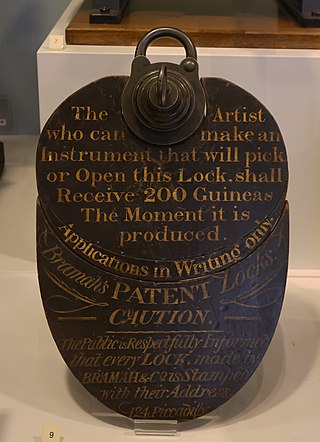
The Bramah lock was created by Joseph Bramah in 1784. The lock employed the first known high-security design.
This is a glossary of locksmithing terms.


















